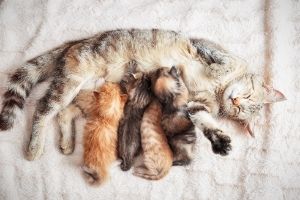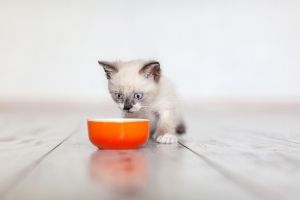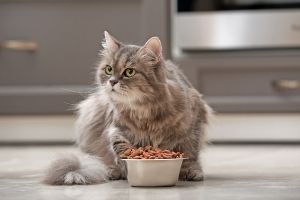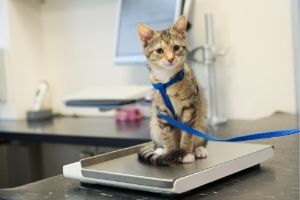Congratulations on your new kitten—your bundle of joy, mischief, snuggles, purrs, and the softest fur you’ll ever feel. You're already likely feeling like you could have never loved another living being this so much, which hopefully means you want to do everything you can to prolong the life of this wee furry feline. One of the best ways you can do that is to get your kitten on the path to good nutrition, and we share tips on how to do that and how to best care for your kitten below.

When Are Kittens Weaned From Their Mothers?
Kittens will still nurse from their mom until they are around six weeks of age and will be completely weaned by the time they are eight weeks if left to their own choice. Some will wean sooner. You can introduce solid food around 4-5 weeks of age by providing wet food and dipping their little paws in it. If you find or obtain a younger kitten, you can purchase milk replacer to bottle feed at a local pet store, or we have some on hand.
You can add some harder kibbles around seven weeks of age, as the wet food will soften the hard food and get the kittens to use to the thicker constancy and flavor of the kibble. Remember, though, kitties who eat canned food remain slimmer and less likely to develop kidney disease because of the added moisture and protein in the canned diet, compared to carbohydrates in dry food.
If you are bringing your kitten home already on solid food—whether wet food, hard kibble, or a combination—mix the same brand and flavor with the preferred diet you may be changing to over a week or two as they transition to their new home. If your kitten has diarrhea, bring them to see a veterinarian immediately. Don’t just assume that this is something all kittens deal with, as this can be a sign of a much more serious health condition. Too many owners watch their kitten fade away not knowing it is full of parasites or something more sinister. Once your kitten is settled and has had a health check with the veterinarian, you can remove the old food from the transition completely.
Kitten Nutrition Myths—Debunked!
Before we move on, let’s do some myth-busting.
Some of the most common myths about kitten nutrition are as follows:
- You should give kittens milk. After eight weeks, kittens do not need milk, and you shouldn’t provide them with any dairy products. Your milk substitutes are also not suitable for your kitten and can make them very sick. Cats actually cannot metabolize lactose.
- Cats love fish, but most cats and kittens are sensitive to fish. It is one of the most common allergies in cats. If you think your cat may be allergic or sensitive to fish, you will want to eliminate it from your cat’s diet.
- Kittens don’t need soft food once they are adults. Kittens and adult cats can benefit from daily wet food. Cats that have food with higher moisture have less risk of kidney disease. Wet food also has fewer carbohydrates and can help with weight loss.

Kitten Feeding Schedules
Now that we got a few the misconceptions out of the way let’s talk about kitten nutrition. You’ll want to decide if you will free feed your kitten or set a schedule. Cats are natural grazers, and you will want to keep this in mind when you chose what will work best for you and your kitten. Here are a few ideas for feeding schedules.
Free-Feeding Schedule - Dry Kibble
If you are free-feeding, leave a food bowl out at all times, and fill it as soon as it empties.
Pros: It is convenient for you and your kitten, and you don’t have to worry about your kitten getting hungry in the middle of the night and waking you up.
Cons: You won’t know how much your kitten is eating, and this can be important to know when discussing your kitten’s growth with their veterinarian. The chances of your kitten becoming overweight increase when you free feed. It is also difficult to determine when something is wrong because it is hard to discern how much a kitty is consuming regularly and if it has decreased or increased.41 \
Hybrid Feeding Schedule - Dry Kibble and Wet Food
A dry kibble and a wet food hybrid feeding schedule can help keep cats from becoming overweight while allowing your kitten to get the much-needed hydration. Place a measured amount of dry food in a bowl once a day and let your kitten eat it at will. Replace the dry kibble with wet food for a portion of their meal. You can feed your kitten dry food during the day and wet at night or vice versa. Your kitten should eat the wet food within an hour of you giving it to them to reduce the risk of it attracting insects and food spoilage. Replace the wet food with the dry kibble once an hour has passed. Measure out exactly how much you think your kitty needs in a day and feed only this much or they can become obese.
Pros: Kitten will get the extra hydration from the wet food and still have access to the dry food. With the measured amount, you will know your kitten’s food intake if you need to discuss with their veterinarian.
Cons: If your kitten eats all the food, they may cry for more. This does not mean to fill the bowl again. You can adjust the feeding schedule to place small amounts in the bowl to snack on throughout the day and a small amount left for night time to help avoid this problem.
Hunting Schedule - Dry Kibble Or Wet Food
A hunting schedule is beneficial for those highly active kittens that need to have extra stimulation by channeling their instincts. With regular feeding, you place your kitten’s food in the same location, but you will move treats around for hunting. Hiding food also reduces boredom feeding when cats get older. You will need multiple bowls for food. For dry food, you can divide up the amount of food for the day and place it in multiple bowls in safe locations for your kitten to find them. Never remove food as your kitten is eating; wait for them to finish and walk away before removing the bowl. Change up the locations frequently. If you are using wet food, remember to remove it within an hour of placing out for your kitten.
Pros: This stimulates the kitten’s instincts and keeps them active and in good shape. You can also use this training method to teach them where you want them to go or not go.
Cons: For little spaces, this can be difficult. It can also take time to think of places to put the food and to make sure that your kitten can get to the food.

How to Make a Transition From Kitten Food
Kittens can be picky eaters and finding food that they will like sometimes can be challenging. Transitioning food should be done over a week or two by mixing the old and new food, as kittens have sensitive stomachs, and the change can cause diarrhea. You should seek veterinary care if your kitten has diarrhea.
The best way to transition food for picky eaters is to have around five days worth of the old food for your kitten. When you take a scoop of food out of the old food to feed your kitten, replace it with the same amount of the new food. Stir it up, and repeat every time you feed. Feeding this way will marry the two smells together for those picky eaters and allow for a nice smooth transition. When you don’t see much of the old food, you can combine the two bags. If the food looks similar, it should take about two weeks for this process and your kitten to acclimate to the new food.
For wet food, open a can of the old food, and replace ? with the new wet food. Don’t mix, as you’ll want to know if your kitten likes the new food. If your kitten likes the new food, you can continue with the transition. Keep the change going slowly, and allow about 5-7 days for your kitten to adjust. Add a little more of the new food each day. Believe it or not, pet appetites thrive on the monotony of a certain diet. The best way to create a picky eater is to change foods frequently. The idea of being bored with a food is a human notion and we are prone to apply logic to our pets because we think we would grow bored of eating the same meal. You can add variety occasionally, but try to limit the introduction of new flavors to limit pickiness.
Some Miscellaneous Kitten Nutrition Tips
Always have fresh water for your kitten in a clean bowl. Some cats love moving water, making a fountain an excellent option for a water bowl. Getting a kitten used to a water fountain when they are young helps entice them to drink.
Don’t be afraid to give treats! Providing treats is a great way to bond with your kitten, primarily when you use them for training. Treats should be less than 5% of their diet. If you have questions, ask us. Calories are higher with treats.
Kittens should remain on kitten food until they are around one year of age when they transition to adult food. Cats do well on adult food for most of their lives, but you should discuss with our veterinarians when your cat should switch to a senior formula.

How to Tell If Your Kitten Or Cat Is Overweight
It is vital to keep your cat at a healthy weight to prevent health conditions like diabetes and arthritis. You can talk to our veterinarians about what other health risks your kitten may have.
Cat body structure is very sleek and will almost be a straight line from shoulder to hip, with a slight indent at the waist. You should not be able to see your cat’s ribs or hips protruding. If you do, increase your cat’s calorie intake. Your cat should have a small tuck in their abdomen, although some indoor cats develop a “pooch” in this area. This pooch is usually due to a lack of horizontal movement and decreased activity as they age. Because cats have different body structures, some will have a healthy body weight at 5 lbs and others at maybe 15lbs. Regular check-ups with our veterinarians to discuss the appropriate weight for your cat are essential for longevity and quality of life.
If you have any more questions about how to get your kitten on the path to wellness through good nutrition, please don’t hesitate to give us a call!



